
Concept explainers
Propose structures for compounds that fit the following 1H NMR data:
(a) C4H6Cl2
2.18 δ (3 H, singlet)
4.16 δ (2 H, doublet, J=7 Hz)
5.71 δ (1 H, triplet, J=7 Hz)
(b) C10H14
1.30 δ (9 H, singlet)
7.30 δ (5 H, singlet)
(c) C4H7BrO
2.11 δ (3 H, singlet)
3.52 δ (2 H, triplet, J=6 Hz)
4.40 δ (2 H, triplet, J=6 Hz)
(d) C9H11Br
2.15 δ (2 H, quintet, J=7 Hz)
2.75 δ (2 H, triplet, J=7 Hz)
3.38 δ (2 H, triplet, J=7 Hz)
7.22 δ (5 H, singlet)
a)

Interpretation:
The proposed structure of the compound to be identified for the given 1HNMR spectrum.
Concept introduction:
HDI calculation:

Where
C represent number of carbons.
N represent number of nitrogens.
H represent number of hydrogens.
X represent number of halogens.
Chemical shift: The frequency of the proton signal in the spectrum with reference to the standard compound which may be TMS(Tetramethylsilane) shows signal at 0 ppm(parts per million).
Multiplicity: The number of peaks on the each signal in NMR spectrum is defined as multiplicity; the multiplicity of each signal indicates the neighboring protons. It is generated by coupling of the subjected protons with the neighboring protons (both subjected and neighbor protons are to be chemically not equivalent) separated by either two or three sigma bonds.
Rule: Multiplicity of each signal is calculated using (n+1) rule only when the neighboring protons are chemically equivalent to each other.
(n+1)
where
n indicates number of neighboring protons
Integration value (I): The integration value at the bottom of the 1HNMR spectrum represents the number of protons giving rise to the signal.
To find:
The structure of the compound to be identified for the given molecular formula and 1HNMR spectrum.
Answer to Problem 55GP
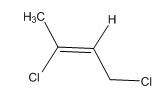
Explanation of Solution
Calculate HDI value:
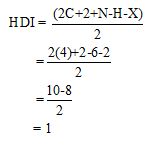
The HDI calculation confirms the presence of an aliphatic ring and double bond
Adjust the relative integration with the number of protons from the molecular formula.
The total number of protons in the molecular formula C10H14 is 6.
Interpret the given information.
Given information:
Three signals with multiplicity and integration values.
2.18ppm(3H, singlet)
4.16ppm(2H, doublet, J=7HZ)
5.71ppm(1H , triplet, J=7HZ)
The HDI value confirms the compound has either a ring or a double bond (one level of unsaturation). The total integration value (3+2+1=6 protons) is also an exact value with the protons of the molecular formula.
A signal at 2.18ppm with integration of 3H’s represents methyl groups which are chemically equivalent having one neighboring proton indicates the characteristic pattern of isopropyl group.
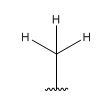
A signal with integration of 2H’s represent a methylene group appears at 4.16ppm rather 5.17ppm, consistent with the value of protons which present at alpha position to vinyl group (C=O) and accounts for the one degree of unsaturation.
The overall predicted structure is:

The methyl groups can be interchanged via no reflectional symmetry and the compound gives rise to totally three signals in spectrum.
The structure of the compound is identified using the details of spectrum and DHI calculation.
b)

Interpretation:
The proposed structure of the compound to be identified for the given 1HNMR spectrum.
Concept introduction:
HDI calculation:

Where
C represent number of carbons.
N represent number of nitrogens.
H represent number of hydrogens.
X represent number of halogens.
Chemical shift: The frequency of the proton signal in the spectrum with reference to the standard compound which may be TMS(Tetramethylsilane) shows signal at 0 ppm(parts per million).
Multiplicity: The number of peaks on the each signal in NMR spectrum is defined as multiplicity; the multiplicity of each signal indicates the neighboring protons. It is generated by coupling of the subjected protons with the neighboring protons (both subjected and neighbor protons are to be chemically not equivalent) separated by either two or three sigma bonds.
Rule: Multiplicity of each signal is calculated using (n+1) rule only when the neighboring protons are chemically equivalent to each other.
(n+1)
where
n indicates number of neighboring protons
Integration value (I): The integration value at the bottom of the 1HNMR spectrum represents the number of protons giving rise to the signal.
To find:
The structure of the compound to be identified for the given molecular formula and 1HNMR spectrum.
Answer to Problem 55GP
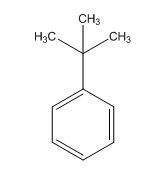
Explanation of Solution
Calculate HDI value:
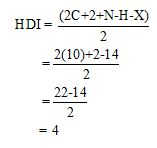
The HDI calculation confirms the presence of an aliphatic ring and double bond
Adjust the relative integration with the number of protons from the molecular formula.
The total number of protons in the molecular formula C10H14 is 14.
Interpret the given information.
Given information:
Three signals with multiplicity and integration values.
1.30ppm(9H, singlet)
7.30ppm(5H, singlet)
The HDI value confirms the compound has either a ring or a double bond (four level of unsaturation). The total integration value (9+5=14 protons) is also an exact value with the protons of the molecular formula.
A signal at 1.30ppm with integration of 9H’s represents methyl groups which are chemically equivalent having one neighboring proton indicates the characteristic pattern of isopropyl group.
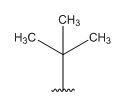
A signal with integration of 5H’s represent a benzene appears at 7.30ppm which present at aromatic group and accounts for the four degree of unsaturation.
The overall predicted structure is:

The methyl groups can be interchanged via reflectional symmetry and the compound gives rise to totally two signals in 1HNMR spectrum.
The structure of the compound is identified using the details of 1HNMR spectrum and DHI calculation.
c)

Interpretation:
The proposed structure of the compound to be identified for the given 1HNMR spectrum.
Concept introduction:
HDI calculation:

Where
C represent number of carbons.
N represent number of nitrogens.
H represent number of hydrogens.
X represent number of halogens.
Chemical shift: The frequency of the proton signal in the spectrum with reference to the standard compound which may be TMS(Tetramethylsilane) shows signal at 0 ppm(parts per million).
Multiplicity: The number of peaks on the each signal in NMR spectrum is defined as multiplicity; the multiplicity of each signal indicates the neighboring protons. It is generated by coupling of the subjected protons with the neighboring protons (both subjected and neighbor protons are to be chemically not equivalent) separated by either two or three sigma bonds.
Rule: Multiplicity of each signal is calculated using (n+1) rule only when the neighboring protons are chemically equivalent to each other.
(n+1)
where
n indicates number of neighboring protons
Integration value (I): The integration value at the bottom of the spectrum represents the number of protons giving rise to the signal.
To find:
The structure of the compound to be identified for the given molecular formula and 1HNMR spectrum.
Answer to Problem 55GP

Explanation of Solution
Calculate HDI value:
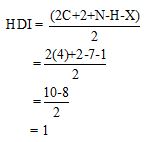
The HDI calculation confirms the presence of an aliphatic ring and double bond
Adjust the relative integration with the number of protons from the molecular formula.
The total number of protons in the molecular formula C4H7Bro is 7.
Interpret the given information.
Given information:
Three signals with multiplicity and integration values.
2.11ppm(3H, singlet)
3.52ppm(2H, triplet, J=6HZ)
4.40ppm(2H, triplet, J=6HZ)
The HDI value confirms the compound has either a ring or a double bond (one level of unsaturation). The total integration value (3+2+2=7 protons) is also an exact value with the protons of the molecular formula.
A signal at 2.11ppm with integration of 3H’s represents methyl groups which are chemically equivalent having one neighboring proton indicates the characteristic pattern of isopropyl group.

A two signal with integration of 2H’s represent a methylene group appears at 3.52ppm rather 4.40ppm, consistent with the value of protons which present at alpha position to carbonyl group(C=O) and accounts for the one degree of unsaturation.
The overall predicted structure is:

The methyl groups can be interchanged via no reflectional symmetry and the compound gives rise to totally three signals in spectrum.
The structure of the compound is identified using the details of 1HNMR spectrum and DHI calculation.
d)

Interpretation:
The proposed structure of the compound to be identified for the given 1HNMR spectrum.
Concept introduction:
HDI calculation:

Where
C represent number of carbons.
N represent number of nitrogens.
H represent number of hydrogens.
X represent number of halogens.
Chemical shift: The frequency of the proton signal in the spectrum with reference to the standard compound which may be TMS(Tetramethylsilane) shows signal at 0 ppm(parts per million).
Multiplicity: The number of peaks on the each signal in NMR spectrum is defined as multiplicity; the multiplicity of each signal indicates the neighboring protons. It is generated by coupling of the subjected protons with the neighboring protons (both subjected and neighbor protons are to be chemically not equivalent) separated by either two or three sigma bonds.
Rule: Multiplicity of each signal is calculated using (n+1) rule only when the neighboring protons are chemically equivalent to each other.
(n+1)
where
n indicates number of neighboring protons
Integration value (I): The integration value at the bottom of the spectrum represents the number of protons giving rise to the signal.
To find:
The structure of the compound to be identified for the given molecular formula and 1HNMR spectrum.
Answer to Problem 55GP

Explanation of Solution
Calculate HDI value:
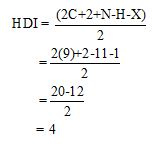
The HDI calculation confirms the presence of an aliphatic ring and double bond
Adjust the relative integration with the number of protons from the molecular formula.
The total number of protons in the molecular formula C9H11Br is 11.
Interpret the given information.
Given information:
Three signals with multiplicity and integration values.
2.15ppm(2H, quintet, J=7HZ)
2.75ppm(2H, triplet, J=7HZ)
3.38ppm(2H, triplet, J=7HZ)
7.22ppm(5H, singlet)
The HDI value confirms the compound has either a ring or a double bond (four level of unsaturation). The total integration value (2+2+2+5=11 protons) is also an exact value with the protons of the molecular formula.
A signal at 2.15ppm with integration of 2H’s represents three methyl groups which are chemically equivalent having one neighboring proton indicates the characteristic pattern of alkyl group.
A signal with integration of 2H’s represent benzylic appears at 2.75ppm which present at aromatic group
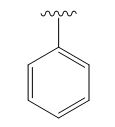
A signal with integration of 5H’s represent benzylic appears at 7.30ppm which present at aromatic group and accounts for the four degree of unsaturation.
The overall predicted structure is:

The methyl groups can be interchanged via reflectional symmetry and the compound gives rise to totally four signals in spectrum.
The structure of the compound is identified using the details of 1HNMR spectrum and DHI calculation.
Want to see more full solutions like this?
Chapter 13 Solutions
OWLv2 with Student Solutions Manual eBook, 4 terms (24 months) Printed Access Card for McMurry's Organic Chemistry, 9th
- Q4: Write organic product(s) of the following reactions and show the curved-arrow mechanism of the reactions. Br MeOH OSO2CH3 MeOHarrow_forwardProvide the correct IUPAC name for the compound shown here. Reset cis- 5- trans- ☑ 4-6- 2- 1- 3- di iso tert- tri cyclo sec- oct but hept prop hex pent yl yne ene anearrow_forwardQ6: Predict the major product(s) for the following reactions. Note the mechanism (SN1, SN2, E1 or E2) the reaction proceeds through. If no reaction takes place, indicate why. Pay attention to stereochemistry. NaCN DMF Br σ Ilm... Br H Br H H NaCN CH3OH KOtBu tBuOH NaBr H₂O LDA Et2O (CH3)2CHOH KCN DMSO NaOH H₂O, A LDA LDA Systemarrow_forward
- Q7: For the following reactions, indicate the reaction conditions that would provide the indicated product in a high yield. Note the major reaction pathway that would take place (SN1, SN2, E1, or E2) Note: There may be other products that are not shown. There maybe more than one plausible pathway. Br H3C OH H3C CI ... H3C SCH2CH3 CI i SCH2CH3 ཨ་ Br System Settarrow_forwardQ2: Rank the compounds in each of the following groups in order of decreasing rate of solvolysis in aqueous acetone. OSO2CF3 OSO2CH3 OH a. b. CI Brarrow_forwardох 4-tert-butyl oxy cyclohex-1-ene Incorrect, 1 attempt remaining The systematic name of this compound classifies the -OR group as a substituent of the hydrocarbon, which is considered the principal functional group. The ether substituent is named with the suffix 'oxy'. The general format for the systematic name of a hydrocarbon is: [prefix/substituent] + [parent] + [functional group suffix] Substituents are listed in alphabetical order. Molecules with a chiral center will indicate the absolute configuration at the beginning of its name with the R and S notation.arrow_forward
- 5. Compressibility (6 points total). The isothermal compressibility is a measure of how hard/easy it is to compress an object (how squishy is it?) at constant temperature. It is др defined as Br=-()=-(200²)T' (a) You might wonder why there is a negative sign in this formula. What does it mean when this quantity is positive and what does it mean when this quantity is negative? (b) Derive the formula for the isothermal compressibility of an ideal gas (it is very simple!) (c) Explain under what conditions for the ideal gas the compressibility is higher or lower, and why that makes sense.arrow_forward19. (3 pts) in Chapter 7 we will see a reaction of halocyclohexanes that requires that the halogen occupy an axial position with this in mind, would you expect cis-1-bromo-3-methylcyclohexane or trans-1-bromo-3-methylcyclohexane to be more reactive in this reaction? Briefly explain your choice using structures to support your answer. Mere-eries-cecleone) The tran-i-browse-3-methylcyclohexionearrow_forwardPlease help me calculate the undiluted samples ppm concentration. My calculations were 280.11 ppm. Please see if I did my math correctly using the following standard curve. Link: https://mnscu-my.sharepoint.com/:x:/g/personal/vi2163ss_go_minnstate_edu/EVSJL_W0qrxMkUjK2J3xMUEBHDu0UM1vPKQ-bc9HTcYXDQ?e=hVuPC4arrow_forward
- Provide an IUPAC name for each of the compounds shown. (Specify (E)/(Z) stereochemistry, if relevant, for straight chain alkenes only. Pay attention to commas, dashes, etc.) H₁₂C C(CH3)3 C=C H3C CH3 CH3CH2CH CI CH3 Submit Answer Retry Entire Group 2 more group attempts remaining Previous Nextarrow_forwardArrange the following compounds / ions in increasing nucleophilicity (least to most nucleophilic) CH3NH2 CH3C=C: CH3COO 1 2 3 5 Multiple Choice 1 point 1, 2, 3 2, 1, 3 3, 1, 2 2, 3, 1 The other answers are not correct 0000arrow_forwardcurved arrows are used to illustrate the flow of electrons. using the provided starting and product structures, draw the cured electron-pushing arrows for thw following reaction or mechanistic steps. be sure to account for all bond-breaking and bond making stepsarrow_forward
 Organic ChemistryChemistryISBN:9781305580350Author:William H. Brown, Brent L. Iverson, Eric Anslyn, Christopher S. FootePublisher:Cengage Learning
Organic ChemistryChemistryISBN:9781305580350Author:William H. Brown, Brent L. Iverson, Eric Anslyn, Christopher S. FootePublisher:Cengage Learning

